God's wildlife







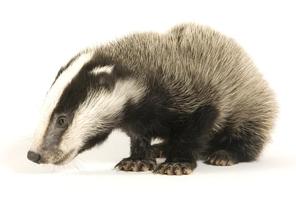
Description
Adult badgers measure 30 inches to 35 inches in length, including a short furry tail. Their bodies are wide and give a flat backed appearance. Many adult badgers weigh 12 pounds to 16 pounds, although weights might increase to over 20 pounds in the late fall as they store up layers of fat to sustain them during periods of cold weather and deep snow.
Ears are set low along the sides of the head. Lower legs and feet are black in color. There are five toes on each foot and four of the toes on the front feet have exceptionally long claws of up 11/2 inches to 1 3/4 inches in length.Badgers have 34 teeth, including four sharply pointed canine teeth.
Reproduction
Badgers mate in August or September. Birth is usually in April, or perhaps as late as June at higher altitudes. Usually 2 to 7 young are born. Although the female has 8 teats, litter sizes tend to be small, and a litter size of 3 is common. Females care for the litter by themselves. The young badgers move out in late summer to begin solitary lifestyles.
Habit
Badgers are territorial throughout most of the year. Most territories are about 3 or 4 square miles. The size of the territory might vary somewhat due to the availability of rodents, a preferred food. Habitats with sandy or porous soils are preferred. Badgers frequent wooded areas when soils are suitable for digging.
Even though Badgers have relatively small territory zones, a number of dens are used regularly over different parts of the territory. These underground dens are quite often elaborate. Most tunnels are 6 to 8 feet deep and 20 to 30 feet long to the main chamber which is elevated to discourage flooding. A smaller chambers also dug underground to serve as a toilet area, and many dens have several entrance holes. Dens that have been used for generations by badgers may have as many as 30 to 40 exits, and tunnels as deep as 15 feet. Bedding grass and leaves are sometimes removed from the den chamber for airing out by a den entrance, after which it is taken back down into the chamber for reuse.
General
Badgers have excellent senses of hearing and smell. Both serve in locating food species, which are usually rodents in underground dens. Badgers have been known to plug the exit holes of prey species before the badger tunnels underground to capture the prey. The long claws serve to loosen the soil and pass it backwards where the hind feet kick the soil out behind the digging animal. This dirt is often kicked backwards 6 to 8 feet in an almost continuous arc by a badger digging in earnest. Badgers close their eyes as they dig underground. They rely upon smell and hearing to continue digging towards the prey.
Badgers are determined fighters when they are threatened. They have loose fitting skin, which prevents them from being held securely by another animal.
Badgers do not hibernate like bears during winter, but they do sleep for extended periods of time in northern states. Especially during extended periods of cold weather and deep snow. Wintering dens can sometimes be found in woodlands, where the frost does not penetrate as deeply. They can stay underground for weeks at a time, but they come out to hunt occasionally as they do not store food.
The condition of it's claws are important to a badger. The species sharpens their long claws by scratching on trees or posts. A badger is considered to be old at 12 years of age
The American species is the most carnivorous of all badgers. It digs out chipmunks, ground hogs, ground squirrels, mice and rabbits and it will eat carrion and invertebrates. Rattlesnakes are eaten when a available but the badgers do not eat the rattlesnake head.
Adult badgers measure 30 inches to 35 inches in length, including a short furry tail. Their bodies are wide and give a flat backed appearance. Many adult badgers weigh 12 pounds to 16 pounds, although weights might increase to over 20 pounds in the late fall as they store up layers of fat to sustain them during periods of cold weather and deep snow.
Ears are set low along the sides of the head. Lower legs and feet are black in color. There are five toes on each foot and four of the toes on the front feet have exceptionally long claws of up 11/2 inches to 1 3/4 inches in length.Badgers have 34 teeth, including four sharply pointed canine teeth.
Reproduction
Badgers mate in August or September. Birth is usually in April, or perhaps as late as June at higher altitudes. Usually 2 to 7 young are born. Although the female has 8 teats, litter sizes tend to be small, and a litter size of 3 is common. Females care for the litter by themselves. The young badgers move out in late summer to begin solitary lifestyles.
Habit
Badgers are territorial throughout most of the year. Most territories are about 3 or 4 square miles. The size of the territory might vary somewhat due to the availability of rodents, a preferred food. Habitats with sandy or porous soils are preferred. Badgers frequent wooded areas when soils are suitable for digging.
Even though Badgers have relatively small territory zones, a number of dens are used regularly over different parts of the territory. These underground dens are quite often elaborate. Most tunnels are 6 to 8 feet deep and 20 to 30 feet long to the main chamber which is elevated to discourage flooding. A smaller chambers also dug underground to serve as a toilet area, and many dens have several entrance holes. Dens that have been used for generations by badgers may have as many as 30 to 40 exits, and tunnels as deep as 15 feet. Bedding grass and leaves are sometimes removed from the den chamber for airing out by a den entrance, after which it is taken back down into the chamber for reuse.
General
Badgers have excellent senses of hearing and smell. Both serve in locating food species, which are usually rodents in underground dens. Badgers have been known to plug the exit holes of prey species before the badger tunnels underground to capture the prey. The long claws serve to loosen the soil and pass it backwards where the hind feet kick the soil out behind the digging animal. This dirt is often kicked backwards 6 to 8 feet in an almost continuous arc by a badger digging in earnest. Badgers close their eyes as they dig underground. They rely upon smell and hearing to continue digging towards the prey.
Badgers are determined fighters when they are threatened. They have loose fitting skin, which prevents them from being held securely by another animal.
Badgers do not hibernate like bears during winter, but they do sleep for extended periods of time in northern states. Especially during extended periods of cold weather and deep snow. Wintering dens can sometimes be found in woodlands, where the frost does not penetrate as deeply. They can stay underground for weeks at a time, but they come out to hunt occasionally as they do not store food.
The condition of it's claws are important to a badger. The species sharpens their long claws by scratching on trees or posts. A badger is considered to be old at 12 years of age
The American species is the most carnivorous of all badgers. It digs out chipmunks, ground hogs, ground squirrels, mice and rabbits and it will eat carrion and invertebrates. Rattlesnakes are eaten when a available but the badgers do not eat the rattlesnake head.
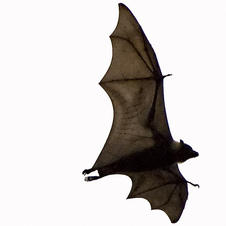
Description
The largest bats have a 6 foot wingspan. The bodies of the smallest bats are no more than an inch long.Most bats live longer than most mammals of their size. The longest known lifespan of a bat in the wild is 30 years for a little brown bat.
Bats are the only mammals capable of true flight. With extremely elongated fingers and a wing membrane stretched between, the bat’s wing anatomically resembles the human hand. Almost 1,000 bat species can be found worldwide. In fact, bats make up a quarter of all mammal species on earth!
Reproduction
Gestation: 40 days - 6 monthsLitter Size: Mostly one pupFor their size, bats are the slowest reproducing mammals on Earth. At birth, a pup weighs up to 25 percent of its mother’s body weight, which is like a human mother giving birth to a 31 pound baby! Offspring typically are cared for in maternity colonies, where females congregate to bear and raise the young. Male bats do not help to raise the pups
Habit
Some bats have evolved a highly sophisticated sense of hearing. They emit sounds that bounce off of objects in their path, sending echoes back to the bats. From these echoes, the bats can determine the size of objects, how far away they are, how fast they are traveling and even their texture, all in a split second
Bats find shelter in caves, crevices, tree cavities and buildings. Some species are solitary while others form colonies of more than a million individuals.
General
70% of bats consume insects, sharing a large part of natural pest control. There are also fruit-eating bats; nectar-eating bats; carnivorous bats that prey on small mammals, birds, lizards and frogs; fish-eating bats, and perhaps most famously, the blood-sucking vampire bats of South America.
Population. To survive the winter some species of bat migrate, others hibernate, and yet others go into torpor.
The largest bats have a 6 foot wingspan. The bodies of the smallest bats are no more than an inch long.Most bats live longer than most mammals of their size. The longest known lifespan of a bat in the wild is 30 years for a little brown bat.
Bats are the only mammals capable of true flight. With extremely elongated fingers and a wing membrane stretched between, the bat’s wing anatomically resembles the human hand. Almost 1,000 bat species can be found worldwide. In fact, bats make up a quarter of all mammal species on earth!
Reproduction
Gestation: 40 days - 6 monthsLitter Size: Mostly one pupFor their size, bats are the slowest reproducing mammals on Earth. At birth, a pup weighs up to 25 percent of its mother’s body weight, which is like a human mother giving birth to a 31 pound baby! Offspring typically are cared for in maternity colonies, where females congregate to bear and raise the young. Male bats do not help to raise the pups
Habit
Some bats have evolved a highly sophisticated sense of hearing. They emit sounds that bounce off of objects in their path, sending echoes back to the bats. From these echoes, the bats can determine the size of objects, how far away they are, how fast they are traveling and even their texture, all in a split second
Bats find shelter in caves, crevices, tree cavities and buildings. Some species are solitary while others form colonies of more than a million individuals.
General
70% of bats consume insects, sharing a large part of natural pest control. There are also fruit-eating bats; nectar-eating bats; carnivorous bats that prey on small mammals, birds, lizards and frogs; fish-eating bats, and perhaps most famously, the blood-sucking vampire bats of South America.
Population. To survive the winter some species of bat migrate, others hibernate, and yet others go into torpor.
Badgers
Bats
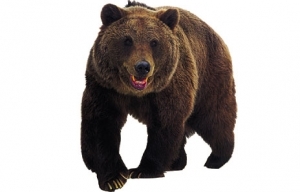
Bears
Description
The American black bear is the smallest of the three bears species found in North America, and are found only in North America. Black bears have short, non-retractable claws that give them an excellent tree-climbing ability.Black bear fur is usually a uniform color except for a brown muzzle and light markings that sometimes appear on their chests.
Reproduction
Mating Season: Summer.Gestation: 63-70 days.Litter Size: 1-6 cubs; 2 cubs are most common.Cubs remain with the mother for a year and a half or more, even though they are weaned at 6-8 months of age. Females only reproduce every second year (or more). Should the young die for some reason, the female may reproduce again after only one year
Habit
Black bears are extremely adaptable and show a great variation in habitat types, though they are primarily found in forested areas with thick ground vegetation and an abundance of fruits, nuts, and vegetation. In the northern areas, they can be found in the tundra, and they will sometimes forage in fields or meadows.
Black bears tend to be solitary animals, with the exception of mothers and cubs. The bears usually forage alone, but will tolerate each other and forage in groups if there is an abundance of food in one area.
Most black bears hibernate depending on local weather conditions and availability of food during the winter months. In regions where there is a consistent food supply and warmer weather throughout the winter, bears may not hibernate at all or do so for a very brief time. Females give birth and usually remain dened throughout the winter, but males and females without young may leave their dens from time to time during winter months.
General
American black bears are omnivorous: plants, fruits, nuts, insects, honey, salmon, small mammals and carrion. In northern regions, they eat spawning salmon.
Black bears will also occasionally kill young deer or moose calves.
It is estimated that there are at least 600,000 black bears in North America. In the United States, there are estimated to be over 300,000 individuals.
The American black bear is the smallest of the three bears species found in North America, and are found only in North America. Black bears have short, non-retractable claws that give them an excellent tree-climbing ability.Black bear fur is usually a uniform color except for a brown muzzle and light markings that sometimes appear on their chests.
Reproduction
Mating Season: Summer.Gestation: 63-70 days.Litter Size: 1-6 cubs; 2 cubs are most common.Cubs remain with the mother for a year and a half or more, even though they are weaned at 6-8 months of age. Females only reproduce every second year (or more). Should the young die for some reason, the female may reproduce again after only one year
Habit
Black bears are extremely adaptable and show a great variation in habitat types, though they are primarily found in forested areas with thick ground vegetation and an abundance of fruits, nuts, and vegetation. In the northern areas, they can be found in the tundra, and they will sometimes forage in fields or meadows.
Black bears tend to be solitary animals, with the exception of mothers and cubs. The bears usually forage alone, but will tolerate each other and forage in groups if there is an abundance of food in one area.
Most black bears hibernate depending on local weather conditions and availability of food during the winter months. In regions where there is a consistent food supply and warmer weather throughout the winter, bears may not hibernate at all or do so for a very brief time. Females give birth and usually remain dened throughout the winter, but males and females without young may leave their dens from time to time during winter months.
General
American black bears are omnivorous: plants, fruits, nuts, insects, honey, salmon, small mammals and carrion. In northern regions, they eat spawning salmon.
Black bears will also occasionally kill young deer or moose calves.
It is estimated that there are at least 600,000 black bears in North America. In the United States, there are estimated to be over 300,000 individuals.
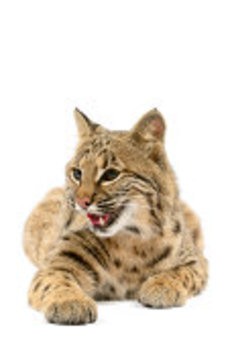
Bobcats
Description
The most common wildcat in North America, the bobcat is named for its short, bobbed tail. They are medium-sized cats and are slightly smaller but similar in appearance to their cousin, the lynx. Their coats vary in color from shades of beige to brown fur with spotted or lined markings in dark brown or black
Reproduction
Mating season: Late winter, but throughout the year is possible.Gestation: 50- 70 days. Kittens are usually born around early spring.Litter size: 1 – 6 kittens.The kittens begin eating solid food at around two months and begin learning to hunt at 5 months. When they are between 8 and 11 months, the kittens are evicted from their mother's territory.
Habit
Bobcat habitat varies widely from forests and mountainous areas to semi-deserts and brush land. A habitat dense with vegetation and lots of prey is ideal. Bobcats are excellent hunters, stalking prey with stealth and patience, then capturing their meals with one great leap.
Usually solitary and territorial animals, females never share territory with each other. Male territories, however, tend to overlap. Territories are established with scent markings and territory sizes are extremely varied – generally 25-30 square miles for males and about five square miles for females.
Dens: Each bobcat may have several dens, one main den and several auxiliary dens, in its territory.
Main den: Usually a cave or rock shelter, but can be a hollow log, fallen tree, or some other protected place. (Also called the natal den) Auxiliary dens: Located in less-visited portions of the home range and are often brush piles, rock ledges or stumps. These are also called shelter dens.
General
Bobcats mainly hunt rabbits and hares. They are also known to eat rodents, birds, bats and even
adult deer, which they usually consume during the winter months, as well as lambs, poultry and young pigs when a ranch is near.
Approximately 725,000 to 1,020,000 bobcats remain in the wild.
Description
Chipmunks are rodents that are a type of squirrel. These small, furry animals are identified by their stubby legs, bushy tails and the white, black and brown stripes that run down their backs.
Size
Chipmunks are the smallest members of the squirrel family, according to National Geographic. The biggest species of chipmunk is the Eastern chipmunk. It grows to 11 inches and weighs up to 4.4 ounces.
. Chipmunks typically grow to around 4 to 7 inches and weigh 1 to 5 ounces Their tails can grow as long as 3 to 5 inches.
Reproduction
Like other rodents, chipmunks have live births after carrying their young for a gestation period of around 30 days. Female chipmunks usually give birth to two to eight young at one time and give birth one to two times per year, once in the late spring and sometimes again in the fall. Their young are called pups. A group of pups that are born to the same mother, at the same time, is called a litter
Habitat
There are 25 species of chipmunk.. In North America, chipmunks can be found almost anywhere there are trees. Chipmunks make homes for themselves by creating burrows that consist of an underground tunnel system or by making nests in logs or bushes. Their tunnel systems can be 10 to 30 feet long.
General
Though you may see chipmunks around each other, they are not social animals. They like to keep to themselves and only interact during mating season, which is in the spring.
They are most active at dusk and dawn. Chipmunks spend most of their days foraging. A single chipmunk can gather up to 165 acorns in a day.
Chipmunks hibernate, but they don't store fat to see them through long winters like bears do. During the warm months, chipmunks will stuff extra food into their cheek pouches. These cheeks are massive grocery bags. They can stretch to be three times larger than the chipmunk's head.
During hibernation, chipmunks can seem like they are dead. Their heart rates can drop from 350 beats per minute to around 4 beats per minute, and their body temperature can drop from 94 degrees Fahrenheit to as cold as 40.
Chipmunks are omnivores, and they aren't picky about what they eat. Part of their diet consists of vegetation such as mushrooms, berries, nuts, seeds and grains. Chipmunks also eat other creatures such as insects, baby birds, frogs and bird eggs.
The most common wildcat in North America, the bobcat is named for its short, bobbed tail. They are medium-sized cats and are slightly smaller but similar in appearance to their cousin, the lynx. Their coats vary in color from shades of beige to brown fur with spotted or lined markings in dark brown or black
Reproduction
Mating season: Late winter, but throughout the year is possible.Gestation: 50- 70 days. Kittens are usually born around early spring.Litter size: 1 – 6 kittens.The kittens begin eating solid food at around two months and begin learning to hunt at 5 months. When they are between 8 and 11 months, the kittens are evicted from their mother's territory.
Habit
Bobcat habitat varies widely from forests and mountainous areas to semi-deserts and brush land. A habitat dense with vegetation and lots of prey is ideal. Bobcats are excellent hunters, stalking prey with stealth and patience, then capturing their meals with one great leap.
Usually solitary and territorial animals, females never share territory with each other. Male territories, however, tend to overlap. Territories are established with scent markings and territory sizes are extremely varied – generally 25-30 square miles for males and about five square miles for females.
Dens: Each bobcat may have several dens, one main den and several auxiliary dens, in its territory.
Main den: Usually a cave or rock shelter, but can be a hollow log, fallen tree, or some other protected place. (Also called the natal den) Auxiliary dens: Located in less-visited portions of the home range and are often brush piles, rock ledges or stumps. These are also called shelter dens.
General
Bobcats mainly hunt rabbits and hares. They are also known to eat rodents, birds, bats and even
adult deer, which they usually consume during the winter months, as well as lambs, poultry and young pigs when a ranch is near.
Approximately 725,000 to 1,020,000 bobcats remain in the wild.
Description
Chipmunks are rodents that are a type of squirrel. These small, furry animals are identified by their stubby legs, bushy tails and the white, black and brown stripes that run down their backs.
Size
Chipmunks are the smallest members of the squirrel family, according to National Geographic. The biggest species of chipmunk is the Eastern chipmunk. It grows to 11 inches and weighs up to 4.4 ounces.
. Chipmunks typically grow to around 4 to 7 inches and weigh 1 to 5 ounces Their tails can grow as long as 3 to 5 inches.
Reproduction
Like other rodents, chipmunks have live births after carrying their young for a gestation period of around 30 days. Female chipmunks usually give birth to two to eight young at one time and give birth one to two times per year, once in the late spring and sometimes again in the fall. Their young are called pups. A group of pups that are born to the same mother, at the same time, is called a litter
Habitat
There are 25 species of chipmunk.. In North America, chipmunks can be found almost anywhere there are trees. Chipmunks make homes for themselves by creating burrows that consist of an underground tunnel system or by making nests in logs or bushes. Their tunnel systems can be 10 to 30 feet long.
General
Though you may see chipmunks around each other, they are not social animals. They like to keep to themselves and only interact during mating season, which is in the spring.
They are most active at dusk and dawn. Chipmunks spend most of their days foraging. A single chipmunk can gather up to 165 acorns in a day.
Chipmunks hibernate, but they don't store fat to see them through long winters like bears do. During the warm months, chipmunks will stuff extra food into their cheek pouches. These cheeks are massive grocery bags. They can stretch to be three times larger than the chipmunk's head.
During hibernation, chipmunks can seem like they are dead. Their heart rates can drop from 350 beats per minute to around 4 beats per minute, and their body temperature can drop from 94 degrees Fahrenheit to as cold as 40.
Chipmunks are omnivores, and they aren't picky about what they eat. Part of their diet consists of vegetation such as mushrooms, berries, nuts, seeds and grains. Chipmunks also eat other creatures such as insects, baby birds, frogs and bird eggs.
Views
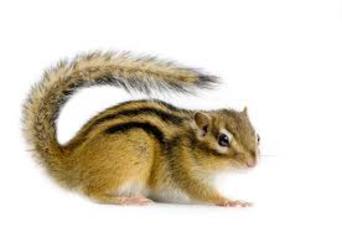
Chipmunks
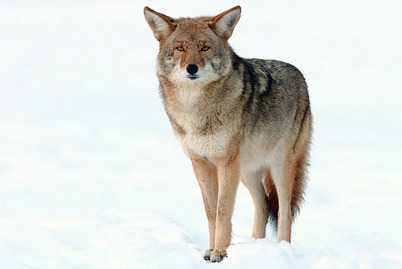
Coyotes
Description
Coyotes have narrow, elongated snouts, lean bodies covered in thick fur, yellow or amber eyes and long, bushy tails. Coyotes have gray, white, tan and brown fur. Their fur color depends on where they live. Coyotes that live in the mountains have darker coats and ones that live in the desert have lighter coats.
Coyotes are about as big as medium-size dogs, though they are smaller than wolves. They are 32 to 37 inches from head to rump. Their tail adds another 16 inches to their length. Coyotes typically weigh about 20 to 50 lbs.
Habitat
Coyotes live in North America and roam the plains, forests, mountains and deserts of Canada, the United States, Mexico and Central America. As humans take over more and more countryside, coyotes are adapting to living in cities to find food. In fact, it is becoming more and more common to see coyotes in big cities like New York and Los Angeles.
Coyotes are solitary creatures and mark their territory with urine. During the winter, coyotes tend to become more social, though. During the cold months, they join forces, creating hunting packs to find food more easily.
These hunters are nocturnal, meaning they sleep during the day and hunt at night. This is why you usually only hear coyotes howling at night. Coyotes howl to communicate their location. They also use other noises to communicate. They make huffing noises to call their pups and they bark at others to tell them to stay away.
Reproduction
Breading season is February to March. In the spring, females build dens in preparation for their young. Females have a gestation period of 63 days and give birth to groups of three to 12 young at once. The groups of babies are called litters and each coyote baby is called a pup. How big the litter size is depends on where the coyotes live. In areas where there are a lot of coyotes, there will be a smaller litter size. In areas with fewer coyotes, the litter size will be larger.
Both the male and female participate in taking care of the pups. The male will bring food to the female and the pups and help protect them from predators.
A female coyote will stay in her den with her pups until their eyes open. This can take 11 or 12 days.
By fall, the pups are old enough to hunt for themselves. Coyotes are usually ready to mate at 20 to 22 months old. In the wild, coyotes live around 14 years.
General
Coyotes are not picky eaters. They are typically thought to be only meat eaters, but they are actually omnivores — they eat meat and vegetation. They eat small game such as rodents, rabbits, fish and frogs, and larger game like deer. When they aren't snacking on bigger prey, they will eat snakes, insects, fruit and grass. Coyotes are known for being pests because they will kill livestock and pets. In cities, coyotes will eat pet food or garbage.
Baby coyotes
Coyotes have narrow, elongated snouts, lean bodies covered in thick fur, yellow or amber eyes and long, bushy tails. Coyotes have gray, white, tan and brown fur. Their fur color depends on where they live. Coyotes that live in the mountains have darker coats and ones that live in the desert have lighter coats.
Coyotes are about as big as medium-size dogs, though they are smaller than wolves. They are 32 to 37 inches from head to rump. Their tail adds another 16 inches to their length. Coyotes typically weigh about 20 to 50 lbs.
Habitat
Coyotes live in North America and roam the plains, forests, mountains and deserts of Canada, the United States, Mexico and Central America. As humans take over more and more countryside, coyotes are adapting to living in cities to find food. In fact, it is becoming more and more common to see coyotes in big cities like New York and Los Angeles.
Coyotes are solitary creatures and mark their territory with urine. During the winter, coyotes tend to become more social, though. During the cold months, they join forces, creating hunting packs to find food more easily.
These hunters are nocturnal, meaning they sleep during the day and hunt at night. This is why you usually only hear coyotes howling at night. Coyotes howl to communicate their location. They also use other noises to communicate. They make huffing noises to call their pups and they bark at others to tell them to stay away.
Reproduction
Breading season is February to March. In the spring, females build dens in preparation for their young. Females have a gestation period of 63 days and give birth to groups of three to 12 young at once. The groups of babies are called litters and each coyote baby is called a pup. How big the litter size is depends on where the coyotes live. In areas where there are a lot of coyotes, there will be a smaller litter size. In areas with fewer coyotes, the litter size will be larger.
Both the male and female participate in taking care of the pups. The male will bring food to the female and the pups and help protect them from predators.
A female coyote will stay in her den with her pups until their eyes open. This can take 11 or 12 days.
By fall, the pups are old enough to hunt for themselves. Coyotes are usually ready to mate at 20 to 22 months old. In the wild, coyotes live around 14 years.
General
Coyotes are not picky eaters. They are typically thought to be only meat eaters, but they are actually omnivores — they eat meat and vegetation. They eat small game such as rodents, rabbits, fish and frogs, and larger game like deer. When they aren't snacking on bigger prey, they will eat snakes, insects, fruit and grass. Coyotes are known for being pests because they will kill livestock and pets. In cities, coyotes will eat pet food or garbage.
Baby coyotes
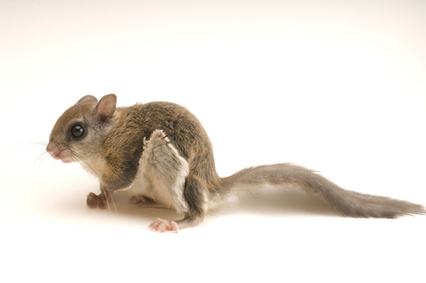
Flying Squirrels
Description
Northern flying squirrels and southern flying squirrels are the only two native flying squirrel species found in North America. They are both gray-brown, but the northern flying squirrel has belly fur that is gray at the base, and for the southern flying squirrel the belly fur is all white.
Size is one way to tell northern and southern flying squirrels apart. The southern species is smaller, about 8 to 10 inches in length. Northern flying squirrels are 10 to 12 inches long.
Habitat
Flying squirrels live in deciduous and coniferous forests and woodlands. They make their homes in snags, woodpecker holes, nest boxes, and abandoned nests of birds and other squirrels. Sometimes multiple squirrels will nest together to keep warm in the winter.
The southern flying squirrel is found throughout the eastern U.S., from Maine south to Florida and west from Minnesota south to Texas. The Northern flying squirrel has a much patchier distribution, but is found primarily in the northeast, along the west coast, and into Idaho and Montana.
Reproduction
The northern flying squirrel mates once per year, but the southern flying squirrel mates twice. When the young are born, they rely on their mothers to care for them for two months
General
Flying squirrels are omnivores. They eat a variety of foods including seeds, nuts, fungi, fruit, and insects. Southern flying squirrels are considered to be one of the most carnivorous squirrels, because they supplement their diet with eggs, birds, and carrion.
Flying squirrels might more appropriately be called “gliding squirrels,” because they aren’t capable of true powered flight that a bird or a bat can do. Flying squirrels glide. They have a special membrane between their front and back legs that allows them to glide through the air between trees. When a flying squirrel wants to travel to another tree without touching the ground, it launches itself from a high branch and spreads out its limbs so that the gliding membrane is exposed. It uses slight movements of the legs to steer, and the tail acts as a brake upon reaching its destination. Flying squirrels can cover more than 150 feet in a single glide!
Flying squirrels can live up to 10 years in captivity, or about half that in the wild.
Northern flying squirrels and southern flying squirrels are the only two native flying squirrel species found in North America. They are both gray-brown, but the northern flying squirrel has belly fur that is gray at the base, and for the southern flying squirrel the belly fur is all white.
Size is one way to tell northern and southern flying squirrels apart. The southern species is smaller, about 8 to 10 inches in length. Northern flying squirrels are 10 to 12 inches long.
Habitat
Flying squirrels live in deciduous and coniferous forests and woodlands. They make their homes in snags, woodpecker holes, nest boxes, and abandoned nests of birds and other squirrels. Sometimes multiple squirrels will nest together to keep warm in the winter.
The southern flying squirrel is found throughout the eastern U.S., from Maine south to Florida and west from Minnesota south to Texas. The Northern flying squirrel has a much patchier distribution, but is found primarily in the northeast, along the west coast, and into Idaho and Montana.
Reproduction
The northern flying squirrel mates once per year, but the southern flying squirrel mates twice. When the young are born, they rely on their mothers to care for them for two months
General
Flying squirrels are omnivores. They eat a variety of foods including seeds, nuts, fungi, fruit, and insects. Southern flying squirrels are considered to be one of the most carnivorous squirrels, because they supplement their diet with eggs, birds, and carrion.
Flying squirrels might more appropriately be called “gliding squirrels,” because they aren’t capable of true powered flight that a bird or a bat can do. Flying squirrels glide. They have a special membrane between their front and back legs that allows them to glide through the air between trees. When a flying squirrel wants to travel to another tree without touching the ground, it launches itself from a high branch and spreads out its limbs so that the gliding membrane is exposed. It uses slight movements of the legs to steer, and the tail acts as a brake upon reaching its destination. Flying squirrels can cover more than 150 feet in a single glide!
Flying squirrels can live up to 10 years in captivity, or about half that in the wild.
MORE WILL BE ADDED SOON!
ATTENTION! This may not all be in alphabetical order.
Description
A mouse is a small rodent with a pointed nose, furry round body, large ears and a long, often hairless, tail. There are hundreds of types of mice, divided into subfamilies of either Old World or New World species. Common varieties include deer mouse, house mouse, field mouse, wood mouse, dormouse, spiny mouse and zebra mouse.
Though some people talk about mice and rats as if they were the same thing, they are actually different types of animals in the rodent family. Rats generally are larger than mice, and they can be bald, scaly and cylinder-shaped
Mice come in a wide variety of colors and sizes. Some common mice colors are white, brown and grey. Some are very tiny and others are around the size of a baked potato.
Mice typically grow from 1 to 7 inches in length and weigh between 0.5 and 1 ounce. The African pygmy is the smallest known mouse on the planet. It measures 1.2 - 3.1 inches and can weigh less than .35 ounces. These measurements do not include tail length. Some mice have tails that are as long as their bodies.
Habitat
Mice are hardy creatures that are found in nearly every country and type of terrain. They can live in forests, grasslands and man made structures easily. Mice typically make a burrow underground if they live out in the wild. Their burrow helps protect them from predators. Their natural predators are cats, birds, wild dogs and foxes.
Mice are nocturnal, meaning they like to sleep during the day. This is why pet mice or house mice can be heard playing or foraging during the night. Most wild mice are timid toward humans and other animals, but they are very social with other mice. Domestic mice are very friendly toward humans and can make good pets for older children and adults.
Reproduction
When homes are infested with mice, humans will often find chewed up wires, books, papers and insulation around their home. Mice aren't eating these items, they are chewing them into pieces that they can use to make their nests. This is because mice nests are made from whatever the female mouse can find.
At around 4 to seven weeks old, a female mouse will mate and have young. She will carry her young for 19 to 21 days and give birth to four to a dozen babies, according to the University of Florida. Mice can have a new litter of babies every three weeks.
Mice have unusual names. Females are does, males are bucks and babies are called pinkies because of their bright pink color. Baby mice are also called pups.
Pet mice can live up to six years, while wild mice usually only live around 1 to 2.5 years
General
If you believe what you see in cartoons, you would think that mice eat cheese. Actually, they like to eat fruits, seeds and grains. They are omnivorous, which means they eat both plants and meat, and the common house mice will eat just about anything it can find. In fact, if food is scarce, mice will even eat each other.
Mice have voracious appetites. They eat around 15 to 20 times per day, so they build their homes nearby places that have readily accessible food sources.
A mouse is a small rodent with a pointed nose, furry round body, large ears and a long, often hairless, tail. There are hundreds of types of mice, divided into subfamilies of either Old World or New World species. Common varieties include deer mouse, house mouse, field mouse, wood mouse, dormouse, spiny mouse and zebra mouse.
Though some people talk about mice and rats as if they were the same thing, they are actually different types of animals in the rodent family. Rats generally are larger than mice, and they can be bald, scaly and cylinder-shaped
Mice come in a wide variety of colors and sizes. Some common mice colors are white, brown and grey. Some are very tiny and others are around the size of a baked potato.
Mice typically grow from 1 to 7 inches in length and weigh between 0.5 and 1 ounce. The African pygmy is the smallest known mouse on the planet. It measures 1.2 - 3.1 inches and can weigh less than .35 ounces. These measurements do not include tail length. Some mice have tails that are as long as their bodies.
Habitat
Mice are hardy creatures that are found in nearly every country and type of terrain. They can live in forests, grasslands and man made structures easily. Mice typically make a burrow underground if they live out in the wild. Their burrow helps protect them from predators. Their natural predators are cats, birds, wild dogs and foxes.
Mice are nocturnal, meaning they like to sleep during the day. This is why pet mice or house mice can be heard playing or foraging during the night. Most wild mice are timid toward humans and other animals, but they are very social with other mice. Domestic mice are very friendly toward humans and can make good pets for older children and adults.
Reproduction
When homes are infested with mice, humans will often find chewed up wires, books, papers and insulation around their home. Mice aren't eating these items, they are chewing them into pieces that they can use to make their nests. This is because mice nests are made from whatever the female mouse can find.
At around 4 to seven weeks old, a female mouse will mate and have young. She will carry her young for 19 to 21 days and give birth to four to a dozen babies, according to the University of Florida. Mice can have a new litter of babies every three weeks.
Mice have unusual names. Females are does, males are bucks and babies are called pinkies because of their bright pink color. Baby mice are also called pups.
Pet mice can live up to six years, while wild mice usually only live around 1 to 2.5 years
General
If you believe what you see in cartoons, you would think that mice eat cheese. Actually, they like to eat fruits, seeds and grains. They are omnivorous, which means they eat both plants and meat, and the common house mice will eat just about anything it can find. In fact, if food is scarce, mice will even eat each other.
Mice have voracious appetites. They eat around 15 to 20 times per day, so they build their homes nearby places that have readily accessible food sources.

Mice
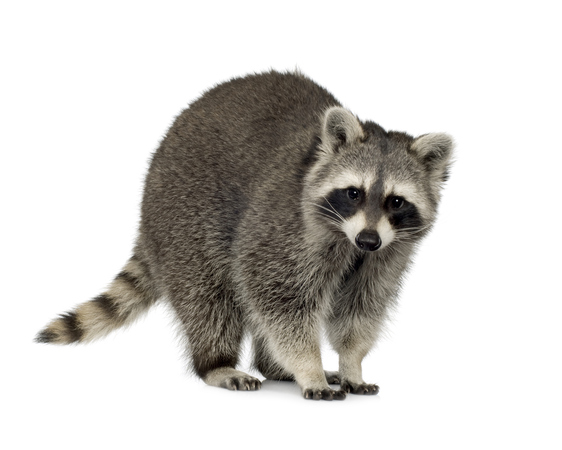
Racoons
Description
The raccoon (also spelled racoon) is easily recognizable by its mask and ringed tail and is often referred to as a "masked bandit". The mask may enhance its vision at night and is also believed to reduce glare when camouflaging itself from predators. Its bushy tail, about 8-12 inches in length, is used as a fat storage, to balance itself when climbing, and to brace itself when sitting up.
Habitat
The raccoon is native to North America and was later introduced to other countries, including Japan and the European mainland. They prefer living in heavily wooded areas near rivers, lakes, or streams but can survive in many regions, including coastal marshes, mountainous areas, and even urban areas. They are the most common wildlife species to live in towns and cities.
It is a fact that the raccoon does not construct its own den. Instead, it relies on natural processes (such as rock crevices and hollow trees) or the work of other animals. It will use several dens within its range of land.
Reproduction
The raccoon is usually nocturnal but can be seen active during the day. The male adult is usually unsociable with other raccoons except during the mating season. Some unrelated males will form a loose group to keep outsiders away. Related females are more sociable with one another.
Breeding occurs mostly between the months of January and March. The male raccoon will mate with more than one female and will have no part in raising the young. The female will give birth to one liter per year. The size of a liter can range from 1-8 kits but the average size is 3-4.
Most baby raccoons are born in the month of April or May. After 6-9 weeks, they begin to explore the world outside of the den and start consuming solid food. By 16 weeks, they are usually weaned. Many females will remain close to their mother while the males usually move away.
General
The raccoon feeds on plants and animals. They prefer fruit and nuts but will also eat grain, insects, worms, fish, birds, garbage, and even bark when times are tough.
Before eating, the raccoon is sometimes seen rubbing the food between its paws and even dipping it into water, as though it was washing it. Researchers don't believe they are washing it but suggest they may be examining it and removing any unwanted parts. Water is thought to increase their sense of touch.
The average weight of a raccoon is 12-20 pounds. Their front paws are very sensitive and manipulative. They can identify an object before touching it and have the ability to open jars, garbage cans, doors, and even complex locks. Their back legs are short compared to their torso, making it difficult for them to run quickly or jump great distances and their hind feet can rotate, making it easy for them to climb down a tree headfirst. Raccoons can cool their bodies by sweating and panting.
The raccoon (also spelled racoon) is easily recognizable by its mask and ringed tail and is often referred to as a "masked bandit". The mask may enhance its vision at night and is also believed to reduce glare when camouflaging itself from predators. Its bushy tail, about 8-12 inches in length, is used as a fat storage, to balance itself when climbing, and to brace itself when sitting up.
Habitat
The raccoon is native to North America and was later introduced to other countries, including Japan and the European mainland. They prefer living in heavily wooded areas near rivers, lakes, or streams but can survive in many regions, including coastal marshes, mountainous areas, and even urban areas. They are the most common wildlife species to live in towns and cities.
It is a fact that the raccoon does not construct its own den. Instead, it relies on natural processes (such as rock crevices and hollow trees) or the work of other animals. It will use several dens within its range of land.
Reproduction
The raccoon is usually nocturnal but can be seen active during the day. The male adult is usually unsociable with other raccoons except during the mating season. Some unrelated males will form a loose group to keep outsiders away. Related females are more sociable with one another.
Breeding occurs mostly between the months of January and March. The male raccoon will mate with more than one female and will have no part in raising the young. The female will give birth to one liter per year. The size of a liter can range from 1-8 kits but the average size is 3-4.
Most baby raccoons are born in the month of April or May. After 6-9 weeks, they begin to explore the world outside of the den and start consuming solid food. By 16 weeks, they are usually weaned. Many females will remain close to their mother while the males usually move away.
General
The raccoon feeds on plants and animals. They prefer fruit and nuts but will also eat grain, insects, worms, fish, birds, garbage, and even bark when times are tough.
Before eating, the raccoon is sometimes seen rubbing the food between its paws and even dipping it into water, as though it was washing it. Researchers don't believe they are washing it but suggest they may be examining it and removing any unwanted parts. Water is thought to increase their sense of touch.
The average weight of a raccoon is 12-20 pounds. Their front paws are very sensitive and manipulative. They can identify an object before touching it and have the ability to open jars, garbage cans, doors, and even complex locks. Their back legs are short compared to their torso, making it difficult for them to run quickly or jump great distances and their hind feet can rotate, making it easy for them to climb down a tree headfirst. Raccoons can cool their bodies by sweating and panting.

Red Fox